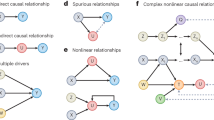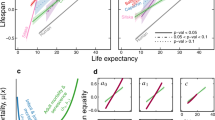Abstract
Driven by technological progress, human life expectancy has increased greatly since the nineteenth century. Demographic evidence has revealed an ongoing reduction in old-age mortality and a rise of the maximum age at death, which may gradually extend human longevity1,2. Together with observations that lifespan in various animal species is flexible and can be increased by genetic or pharmaceutical intervention, these results have led to suggestions that longevity may not be subject to strict, species-specific genetic constraints. Here, by analysing global demographic data, we show that improvements in survival with age tend to decline after age 100, and that the age at death of the world’s oldest person has not increased since the 1990s. Our results strongly suggest that the maximum lifespan of humans is fixed and subject to natural constraints.
This is a preview of subscription content, access via your institution
Access options
Subscribe to this journal
Receive 51 print issues and online access
$199.00 per year
only $3.90 per issue
Buy this article
- Purchase on Springer Link
- Instant access to full article PDF
Prices may be subject to local taxes which are calculated during checkout


Similar content being viewed by others
References
Oeppen, J. & Vaupel, J. W. Demography. Broken limits to life expectancy. Science 296, 1029–1031 (2002)
Vaupel, J. W. Biodemography of human ageing. Nature 464, 536–542 (2010)
Austad, S. N. in Molecular and Cellular Biology of Aging (eds Vijg, J., Campisi, J. & Lithgow, G. ) Ch. 2 (The Gerontological Society of America, 2015)
Jeune, B. et al.. in Supercentenarians (eds H. Maier et al.) (Springer, 2010)
Kenyon, C. The plasticity of aging: insights from long-lived mutants. Cell 120, 449–460 (2005)
Wilmoth, J. R., Deegan, L. J., Lundström, H. & Horiuchi, S. Increase of maximum life-span in Sweden, 1861–1999. Science 289, 2366–2368 (2000)
Blagosklonny, M. V. Why human lifespan is rapidly increasing: solving “longevity riddle” with “revealed-slow-aging” hypothesis. Aging 2, 177–182 (2010)
The Human Mortality Database (http://www.mortality.org, 2016)
Maier, H. et al. Supercentenarians (Springer, 2010)
Fries, J. F. Aging, natural death, and the compression of morbidity. N. Engl. J. Med. 303, 130–135 (1980)
Olshansky, S. J., Carnes, B. A. & Cassel, C. In search of Methuselah: estimating the upper limits to human longevity. Science 250, 634–640 (1990)
Vijg, J. & Kennedy, B. K. The Essence of Aging. Gerontology 62, 381–385 (2016)
Finch, C. E. Longevity, Senescence, and the Genome (Univ. Chicago Press, 1990)
Vijg, J. Aging of the Genome (Oxford, 2007)
Longo, V. D. et al. Interventions to slow aging in humans: are we ready? Aging Cell 14, 497–510 (2015)
Vijg, J. & Campisi, J. Puzzles, promises and a cure for ageing. Nature 454, 1065–1071 (2008)
Acknowledgements
We thank T. Wang for his suggestions on the statistical analysis. This study was supported by grants from the NIH to J.V. (AG017242 and AG047200), the Albert Einstein College of Medicine Institute for Aging Research/Nathan Shock Center, and the Paul F. Glenn Center for the Biology of Human Aging at the Albert Einstein College of Medicine.
Author information
Authors and Affiliations
Contributions
X.D. and B.M. performed data analysis. X.D., B.M. and J.V. wrote the manuscript.
Corresponding author
Ethics declarations
Competing interests
The authors declare no competing financial interests.
Additional information
Reviewer Information
Nature thanks J.-M. Robine and the other anonymous reviewer(s) for their contribution to the peer review of this work.
Extended data figures and tables
Extended Data Figure 1 Life expectancy over time since 1900 (or the earliest year for which data was available) in 40 countries and territories.
There is a generally positive trend over time; life expectancy in Japan appears to be reaching a plateau, but the increase looks unabated in many of the other countries. The data represent the entire population for each region, except Scotland, where it represents only the civilian population. The colour scheme is as in Fig. 1a.
Extended Data Figure 2 Proportion of the population surviving to old age among females in 40 countries and territories.
The data represent the entire population for each region, except Scotland, where it represents only the civilian population. The colour scheme is as in Fig. 1b.
Extended Data Figure 3 Proportion of the population surviving to old age among males in 40 countries and territories.
The data represent the entire population for each region, except Scotland, where it represents only the civilian population. The colour scheme is as in Fig. 1b.
Extended Data Figure 4 Rate of change in survival since 1900 (or the earliest year for which data was available) to a given age as a function of that age in 40 countries and territories.
The rate of change is the slope of the line calculated by an exponential regression, that is, b in the equation y = a + bx, where x is age and y is the logarithm of the number of survivors to that age per 100,000. Including France, 90% (37/41) of the regions examined exhibited the pattern depicted in Fig. 1c.
Extended Data Figure 5 Age with the greatest increase in survival as a function of calendar year in 40 countries and territories.
For each year, the age with the greatest increase in survival over the past 100 years (or since the earliest year for which data was available), that is, the peak of a graph like that from Extended Data Fig. 4, was determined. Including France (Fig. 1d), a total of 82 data sets were considered (males and females in each region); we used linear regressions of segments of the data to look for evidence of plateaus. A data set was considered to be plateauing if one of the following criteria applied: the second half of the data had a negative slope; the first half of the data had a negative slope (as an increase in the second half would likely reflect a return to some equilibrium after being negatively perturbed); the first half of the data had a slope greater than that of the second half of the data; or the final 10% of the data had a slope less than that of the preceding 40%. In 88% (72/82) of the data sets, there was evidence of a plateau.
Extended Data Figure 6 The yearly maximum reported age at death from the GRG database (worldwide, 1972–2015).
The lines represent the functions of linear regressions.
PowerPoint slides
Rights and permissions
About this article
Cite this article
Dong, X., Milholland, B. & Vijg, J. Evidence for a limit to human lifespan. Nature 538, 257–259 (2016). https://doi.org/10.1038/nature19793
Received:
Accepted:
Published:
Issue Date:
DOI: https://doi.org/10.1038/nature19793
This article is cited by
-
A Contractarian Approach to Actuarial Fairness
Journal of Business Ethics (2024)
-
Bayesian modelling of best-performance healthy life expectancy
Journal of Population Research (2024)
-
Seven knowledge gaps in modern biogerontology
Biogerontology (2024)
-
Life expectancy among older adults with or without frailty in China: multistate modelling of a national longitudinal cohort study
BMC Medicine (2023)
-
Colorectal cancer surgery in octogenarians: real-world long-term results
Langenbeck's Archives of Surgery (2023)
Comments
By submitting a comment you agree to abide by our Terms and Community Guidelines. If you find something abusive or that does not comply with our terms or guidelines please flag it as inappropriate.



